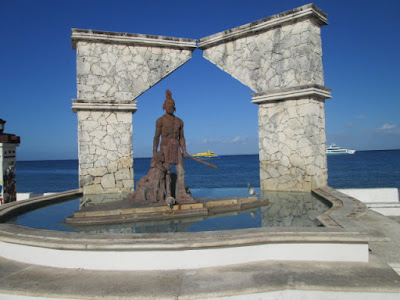A cultural difference I am noticing: the (admittedly limited) parts of Mexico I have visited are very upfront about their bloody history. More importantly, they take pride in the mixed identity of modern Mexico. While Merida has a more diverse ethnic mix, with folks from China, Korea, Lebanon, and Italy wandering in during the 19th century (and never mind the flood from everywhere today), Cozumel has won my heart with the public art along its waterfront. Not only is there a fountain for Ixchel and a pyramid topped with a Franciscan chapel , right on one of the prettiest stretches of the Caribbean, just up the street from the city museum, is the Monument of Two Cultures, sometimes called the Monument to Los Mestizos. This complicated structure celebrates race mixing. (Take that, alt-right!)
The story told in the monument is one of shipwreck, conquest, love, and hard choices. In 1511, a shipwreck caused some would-be conquistadores to wash up on the shores of what is today Quintana Roo, in the land of the Maya. Some were sacrificed, some escaped and were enslaved by other groups, and two remained with the original group of Maya. (Historical note: the Maya of this period were no nicer than most other empires.) A few years later, Cortes, on his way to destroy Tenochtitlan and found Mexico City, landed on the Isla de Cozumel and sent for the two Spaniards still living with the Maya. One of the shipwreck survivors, a Franciscan friar, rejoined the Spaniards and served as an interpreter, but the other refused. This man, Gonzalo Guerrero, had become Maya: he had a wife, children, and an honored place in the society of the people who had saved his life (okay, after enslaving him first). Go home? This is my home. Rejoin my people? These are my people. Seek honor and glory? I have them right here. Or at least, that’s how I read the face on this sculpture.
I have to argue, however, with the depiction of the wife in this monument. Not only is she physically smaller than her spouse (as she probably would have been, the Maya of my acquaintance not being very tall people), she is depicted sitting on the ground, beneath him, behind him, and looking up to him.
Now I have no problem with a woman sitting
down to feed an infant, as she is doing, or looking up to a spouse, for that
matter, but the artistic choice here is troubling. On the Island of the
Goddess, she should at least be his artistic equal, and Zazil Ha, the actual historical
person, was a princess, the esteemed daughter of a warrior king. One early
account, based on the stories of the friar who returned to the Spaniards, has
her referring to Cortes’s emissary as “a slave” and ordering him to get out of
town. Hardly a sweet, submissive little thing.
The sculptor, however, included another detail that I love, and one that carries a subversive message. This couple had three children: the eldest is the son standing next to his father, one is the infant being nursed by the mother, but the third child is sitting on the ground behind the other figures. This third child is playing with a conquistador’s helmet: a soldier's armor has become a child’s toy.
But another message was delivered this morning. A rather handsome bird landed on the warrior’s elaborate hairstyle, preened for a while, then flew off. The human stories told in the monument seemed not to interest the bird at all.








No comments:
Post a Comment